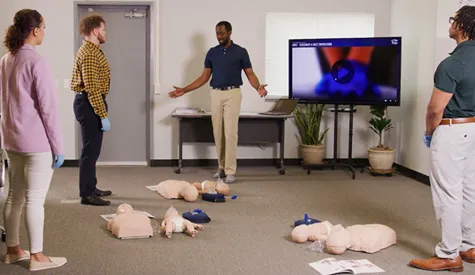How to Become a CPR Instructor: For New and Experienced Instructors

CPR instructors have the unique opportunity to train community and workplace responders, including healthcare providers, first responders, law enforcement, caregivers, childcare providers, teachers — the list goes on.
As a CPR instructor, you’ll have the ability to have a long-lasting impact. Afterall, the person you train today could save the life of a loved one or a complete stranger tomorrow.
Whether you are brand new to the emergency care training world or have years of teaching experience, here are some things to consider.
Determine if being a CPR instructor is right for you
CPR instructors must balance a wide range of responsibilities. This includes everything from becoming a subject matter expert to maintaining training records to managing student behaviors.
First and foremost, a CPR instructor must be knowledgeable and skilled in the material they’ll be teaching. This means learning the ins and outs of the CPR, AED and First Aid training core content and following the accepted methods for delivering program content. It also requires understanding the processes required for CPR certification.
Instructors must also be adept at managing a classroom. The main goal is to improve student skills and performance in emergency care. This requires the ability to maintain your students’ attention. It also means a willingness to meet your students’ specific needs by being aware of various barriers to learning, such as:
- Previous poor learning experiences in other CPR courses.
- Lack of motivation if attendance is viewed only as a way to meet a workplace requirement.
- Common classroom distractions, including cell phones and student conversations.
Additionally, students might feel intimidated by CPR or by the thought of using an AED. It’s up to the CPR instructor to recognize potential barriers and adapt to the situation to produce the best possible outcome for their students.
Choose a CPR instructor training program that will support you
Whether you want to provide CPR training to your organization, establish a full-time career or earn extra money in your spare time, the support of the organization behind the CPR and First Aid programs is a key factor.
When considering any organization, you’ll want to inquire about:
- Access to a training management software
- Flexible program materials allowing you to use your expertise to decide the best teaching approach for your students
- Multiple delivery systems for training
- Program approvals and recognition
- Technical and customer support
- Training supplies and additional sales opportunities
- Student-to-instructor ratios
When talking to any organization, be sure to inquire about additional fees for any of these instructor-support services.
Be willing to grow as a CPR instructor
Every CPR instructor has their own teaching style and personal touch. Some instructors have many years of experience in the field responding to real emergencies. Whereas other instructors have spent time carefully learning the full details of the curriculum.
Although everyone may approach CPR training differently, there are certain traits that all successful CPR instructors have in common.
An HSI survey of experienced emergency care instructors revealed that a skillful instructor has:
- Good social skills
- Effective time management
- Objectivity
- Accurate documentation skills
- Strong ethics
- Dependability
- Professional appearance
- High motivation
- Self-confidence
- Patience
CPR instructors have a deep intrinsic motivation to help others and make a lasting difference in their communities. They are lifelong learners who leverage their passion for helping others to continuously make improvements to their teaching abilities.
A great instructor is always improving by:
- Using ongoing self-evaluation and practice to maintain good instructional skills.
- Always learning new ideas and techniques to improve your CPR classes.
- Joining and participating in related online discussion groups to boost your CPR knowledge and business activities.
- Seeking and sharing feedback.
Ultimately, the heart of being a CPR instructor is serving as a dedicated advocate and mentor for those you train.
Ready to become a CPR instructor?
HSI’s high-quality training programs are designed to be flexible for Instructors to teach and engaging for students to learn. As an HSI instructor, you’ll have access to free training management software, excellent customer service and technical support team, training supplies and additional sales opportunities for your business.
It only takes a few steps to become an HSI approved training center and authorized instructor. Which process you choose will depend on whether you’re already a CPR instructor or not.
Option 1: Become a CPR instructor by attending an Instructor Development Course
For new instructors, you can become a CPR instructor in as little as one day by attending a CPR, AED and First Aid Instructor Development Course (IDC). These courses are available to instructor candidates across the United States with weekly class dates, meaning you can find a CPR instructor course in a city near you on your schedule.
The IDC is comprised of an online cognitive training segment followed by an in-person or virtual, instructor-led course that is generally 3-4 hours long. After successful completion of both components, you’ll be able to train and certify students in CPR, AED and First Aid.
You’ll also have the option to teach other HSI programs, such as Basic Life Support (BLS) and Active Violence Emergency Response Training (AVIRT). Note that additional fees and training might apply.
Option 2: Become an HSI instructor through our reciprocity program
If you’re a current instructor with another nationally recognized organization such as the American Heart Association or American Red Cross, you can use your existing CPR instructor certification to become an HSI instructor.
Our portfolio of high-quality certification programs is competitively priced, giving instructors the best value. Additionally, all HSI programs are designed with a toolbox approach, allowing instructors to adapt training as they see fit.
With HSI, instructor and training center support is at the center of what we do. We strive to continuously develop new training resources and enhance our Otis system platform to help streamline instructor and training center processes. We also serve as a one-stop-shop for programs and training products and accessories, including CPR mannequins, AEDs, CPR masks, and student supplies.
To get started, fill out our reciprocity application and our team will reach out with more information. The next step will include watching a short online course to orient you to HSI.


